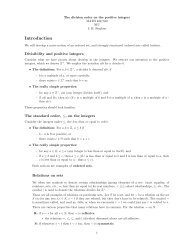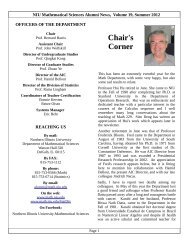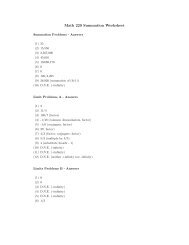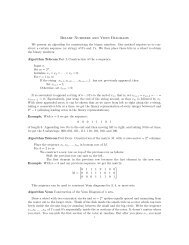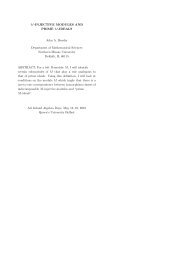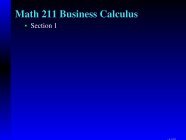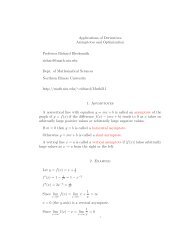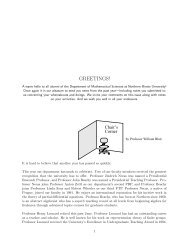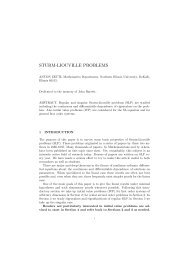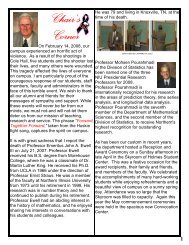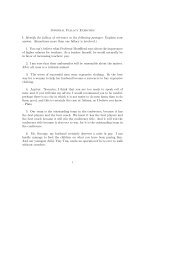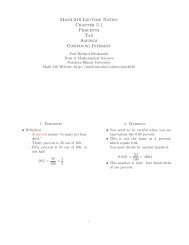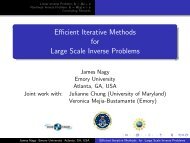abstract algebra: a study guide for beginners - Northern Illinois ...
abstract algebra: a study guide for beginners - Northern Illinois ...
abstract algebra: a study guide for beginners - Northern Illinois ...
Create successful ePaper yourself
Turn your PDF publications into a flip-book with our unique Google optimized e-Paper software.
28 CHAPTER 3. GROUPS<br />
47. Let T be the set of functions tc,d : R 2 → R 2 defined by tc,d(x1, x2) = (x1 + c, x2 + d),<br />
where c, d are any elements of R. Show that T is a group under composition of<br />
functions.<br />
48. Let G be a group. For x, y ∈ G, define x ∼ y if there exists some element a ∈ G such<br />
that y = axa −1 . Show that ∼ defines an equivalence relation on G.<br />
Note: This is a general case of Exercise 2.3.15 in the text.<br />
3.2 Subgroups<br />
Many times a group is defined by looking at a subset of a known group. If the subset is<br />
a group in its own right, using the same operation as the larger set, then it is called a<br />
subgroup. For instance, any group of permutations is a subgroup of Sym(S), <strong>for</strong> some set<br />
S. Any group of n × n matrices (with entries in R) is a subgroup of GLn(R).<br />
If the idea of a subgroup reminds you of <strong>study</strong>ing subspaces in your linear <strong>algebra</strong> course,<br />
you are right. If you only look at the operation of addition in a vector space, it <strong>for</strong>ms an<br />
abelian group, and any subspace is automatically a subgroup. Now might be a good time<br />
to pick up your linear <strong>algebra</strong> text and review vector spaces and subspaces.<br />
Lagrange’s theorem (Theorem 3.2.10) is a very important result. It states that in a<br />
finite group the number of elements in any subgroup must be a divisor of the total number<br />
of elements in the group. This is a useful fact to know when you are looking <strong>for</strong> subgroups<br />
in a given group. In particular, any group of prime order contains no proper nontrivial<br />
subgroups and must there<strong>for</strong>e be cyclic.<br />
It is also important to remember that every element a in a group defines a subgroup<br />
〈a〉, consisting of all powers (positive and negative) of the element. This subgroup has o(a)<br />
elements, where o(a) is the order of a. If the group is finite, then to find 〈a〉 you only need<br />
to calculate the positive powers of a, since in that case the inverse a−1 of any element can<br />
be expressed in the <strong>for</strong>m an , <strong>for</strong> some n > 0.<br />
Lagrange’s Theorem implies that the order of any element of a finite group is a divisor<br />
of the order of the group. This can be extremely helpful, as the following example shows.<br />
. Since<br />
|Z × 17<br />
Suppose that we are attempting to show that [2]17 is a generator of the group Z × 17<br />
| = 17, the possible orders of [2] are 2, 4, 8, or 16. We do not have to calculate all<br />
powers of [2] to find its order. We have [2] 2 = [4], [2] 4 = [16] = [−1], so [2] does not have<br />
order 2 or 4, but the [2] 8 = ([2] 4 ) 2 = [−1] 2 = [1] so [2] has order 8, showing that [2] is not<br />
a generator. A similar argument shows that [3] 2 = [9], [3] 4 = [−4], and [3] 8 = [16], so [3] is<br />
a generator of Z × 17 since it must have order 16.<br />
SOLVED PROBLEMS: §3.2<br />
28. In Zn, show that if gcd(a, n) = d, then 〈[a]n〉 = 〈[d]n〉.<br />
Note: This result is very useful when you find cyclic subgroups of Zn.



